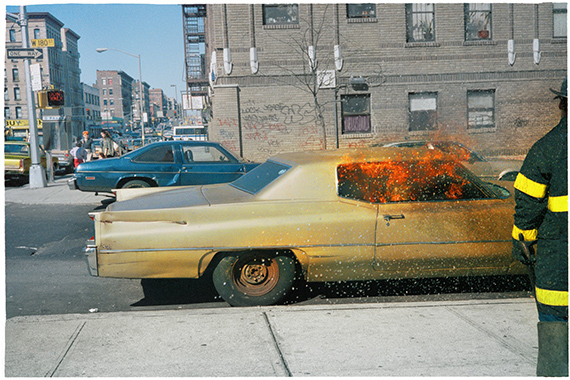
Archival inkjet print, image size: 10 1/2 x 16 inches, paper size: 13 x 18 inches, edition of 12.
Judy Linn »
For Ruth Roman
Exhibition: 12 Jan – 29 Feb 2020
Sun 12 Jan 14:00
Parker Gallery
2441 Glendower Ave
CA 90027 Los Angeles
+1-213-631 1343
info@parkergallery.com
parkergallery.com
Thu-Sat 12-18
For her exhibition with Parker Gallery, the artist’s first solo show in Los Angeles, Judy Linn will exhibit a group of black-and-white and color photographs taken over the last 31 years.
Linn’s pictures traverse genres, occupying an interstitial space between snapshots, the found still-life, and documentary photography. As evidenced by her images taken in everyday, often unremarkable environments, Linn’s work appears spontaneous, yet her work is not oriented towards action. Her work as a photographer takes place in the moments just before or after the action has oc- curred, during a period of reflection, but never in between. Linn refuses to cede to the seductive power of photography’s time-freezing nature, focusing instead on something that has been there and will remain.
As she has chosen to do for exhibitions in the past, the presentation will include prints pinned directly to the wall —an act that brings attention to the paper as an object, the relationships that form between image to border, and from one paper’s edge to another—together with framed prints. Deliberately pinning a print to the wall minimizes the preciousness of the illusion, while revealing its vulner- able, naked, and bare existence. Pinning also implies that the sequencing and arrangement are buoys, subject to shifting. In contrast, the framed work within the grouping are anchors along Linn’s route.
With Linn’s work, assumptions are permissible. In bud can (2012), a can of Budweiser, photographed in upstate New York, the artist has thrust the found con- tainer through a branch. It has been seen that way before: the sun has bleached the red label on one side, and the slit on the can appears too fine for it to have been smashed against the branch. But it has. It was sliced open and penetrated. Bud can is more black-and-white than color, but more color than black-and-white.
In another work, book shelf (2007), Linn has taken a photograph of the back of an art book. It’s a reproduction of an oil painting from 1655, framed by an industrial book shelf. The white flash of the camera has blown out the female subject’s head, while the male portraitist (Gerard ter Borch) has chosen to study the back of her dress, her neck, and the vibrant red bed hangings in front of her. On the bed: a kinky brush.
In a reversal, Linn turns the camera to her TV—a piece of talking furniture in the living room—in Karlson Movie (2000). Here, a color photo of a black-and- white film depicts a cartoonishly sinister pair of “Bowery Boys” eyes that peek out from behind an upholstered chair. A bulky pillow is placed absurdly on the character’s head, while the curtained background helps to camouflage him. Who is he creeping on? What fantasy is he reenacting? There’s a dynamic comedic standoff at play here: Linn aiming her camera at her tiny television set that squats on a table inches from the floor.
Burning car (1986) is as vibrant as it is shocking. Shocking not only in its subject matter, but for its presence amongst the other works, tipping the equilib- rium of the more static pictures. Passersby hardly react, except for a young girl who looks back at the chaos behind her like Lot’s wife. At the edge of the frame, the fireman has put aside his duty and seems frozen in his resignation to just let the car burn. Linn was out shooting with Helen Levitt when she came across the burning Cadillac.
As if culled from Life Magazine’s archive, Linn’s tilted house (2002) is a pho- tograph of a new ideal American home in a picturesque landscape. The uneasy balance causes a tilt to the viewer’s head (not unlike a curious dog) to correct the horizon line, in the quest to see a straight photograph.
Judy Linn (b. 1947 in Detroit, MI, lives and works in Stone Ridge, NY). Since graduating from Pratt Institute in 1969, Linn has photographed the art and music scene in 1970s New York City, had a stint as a newspaper photographer for the Detroit Area Weekly News (1972-73), published a book of photographs of Patti Smith, and taught at Pratt and Vassar, among other institutions. Solo exhibitions include those held at Janice Guy (in collaboration with MBnB), Harlem, New York (2019); Cue Art Foundation, New York (2018); Haus am Kleistpark, Berlin (2015); Esther Massry Gallery, College of Saint Rose, Albany, NY (2014); Atlanta Contemporary Art Center (2008); Presentation House Gallery, Vancouver (2007); and White Columns, New York (2005). Her work has also been included in numerous group exhibitions including Deana Lawson, Judy Linn, Paul Mpagi Sepuya, Sikkema Jenkins & Co, New York (2017); Who Shot Rock & Roll: A Photographic History, 1955 to the Present, Brooklyn Museum (2009); Strange Messenger, Museum Boijmans van Beuningen, Rotterdam (2004); and the 1995 Whitney Biennial.